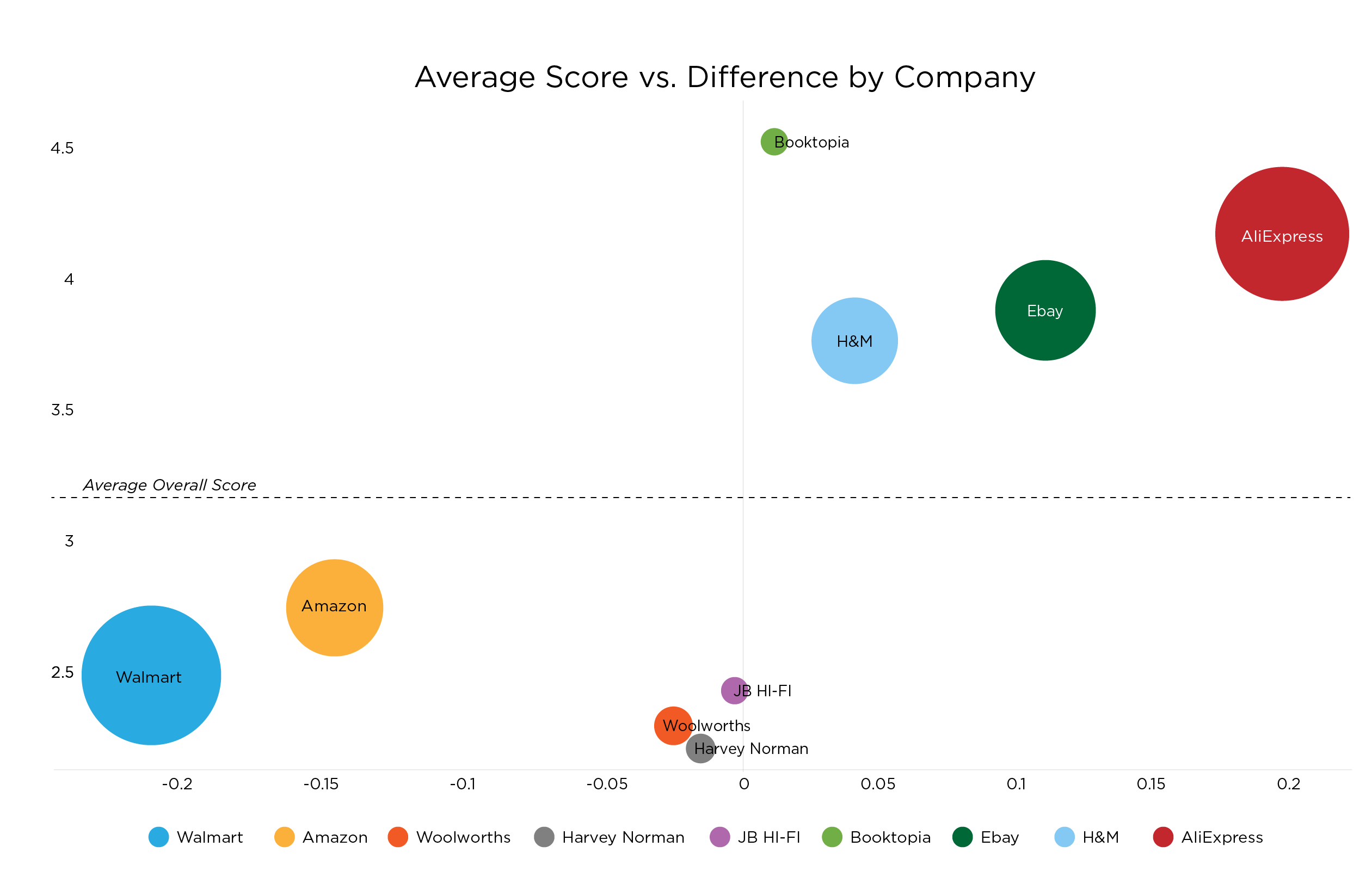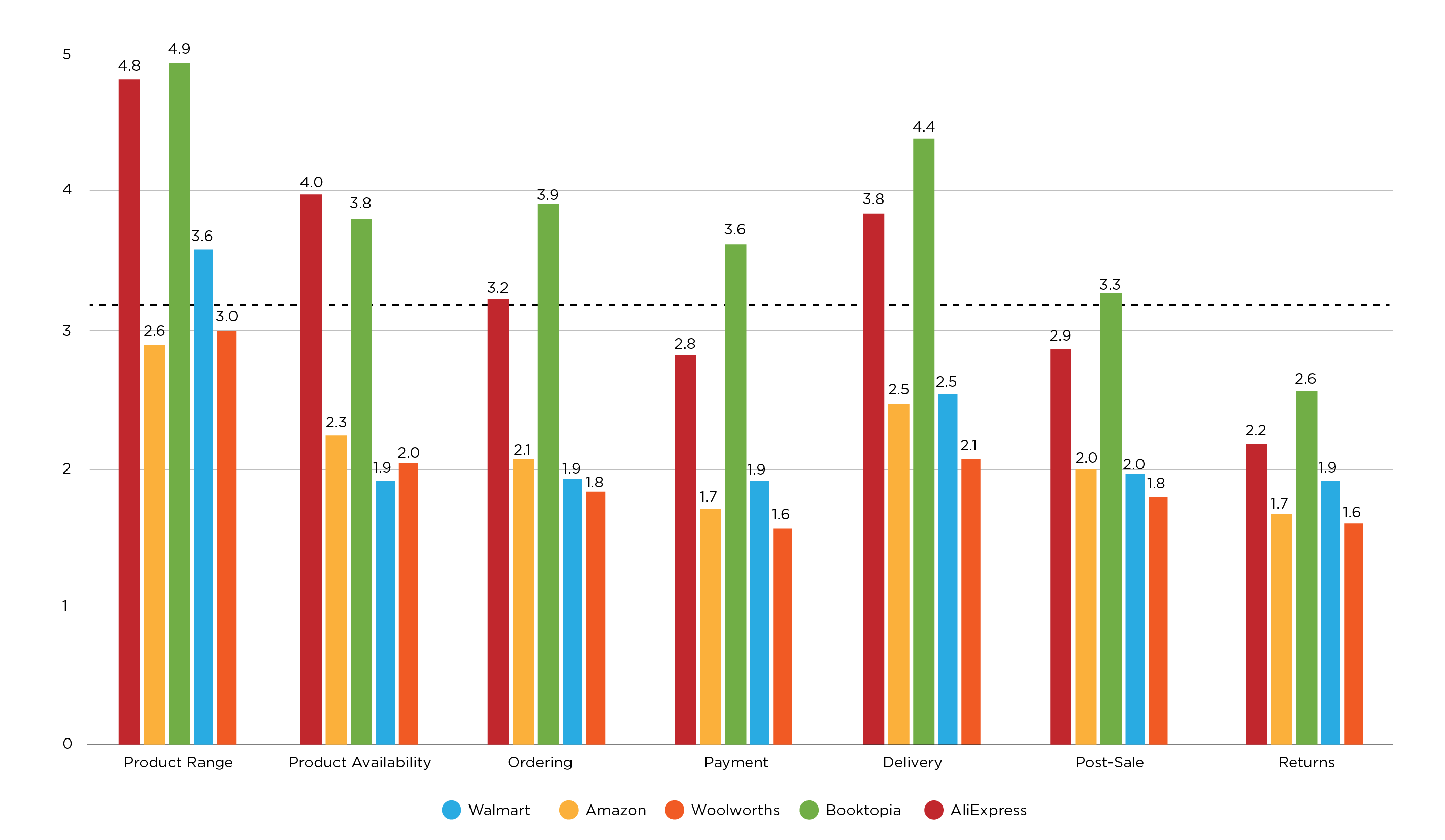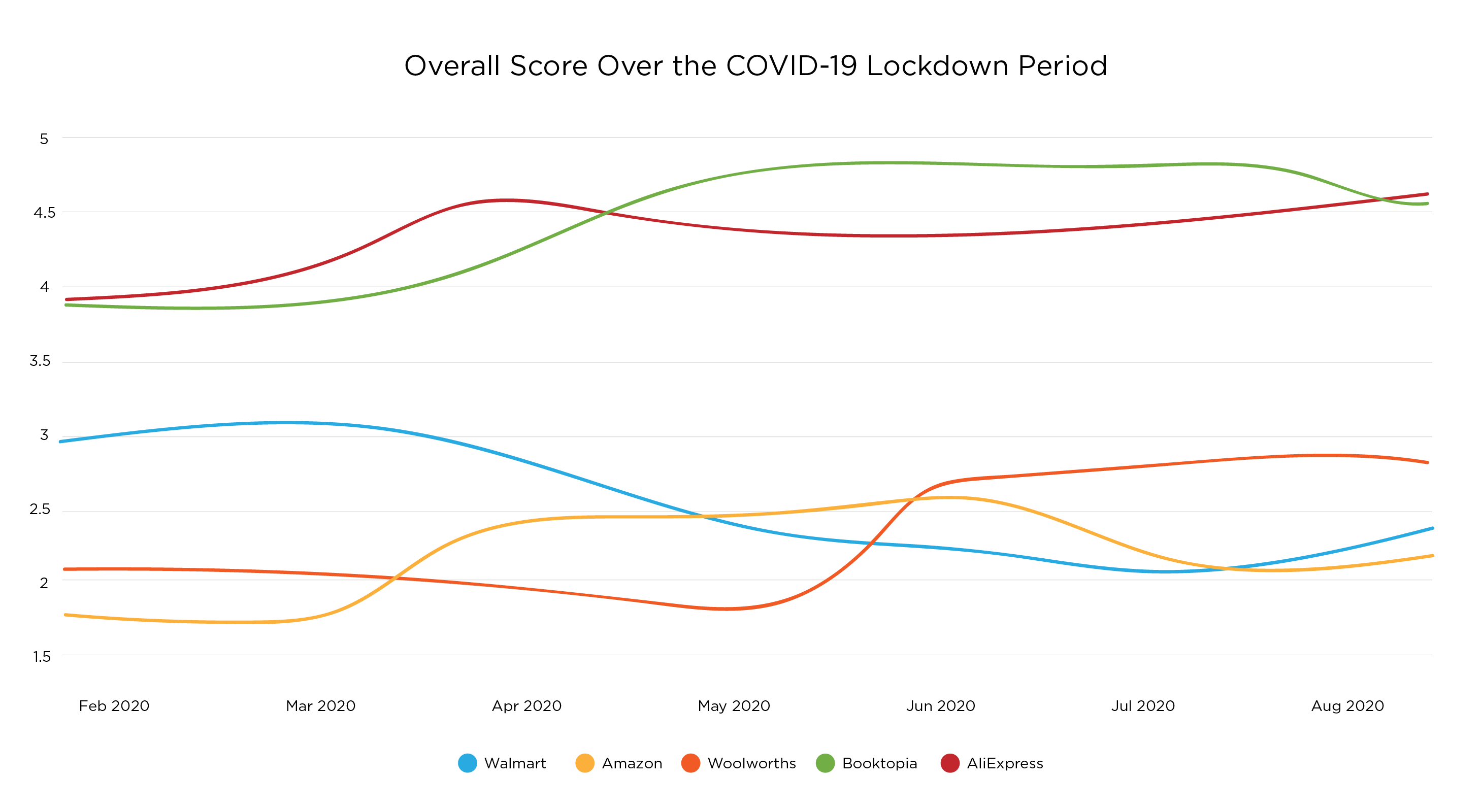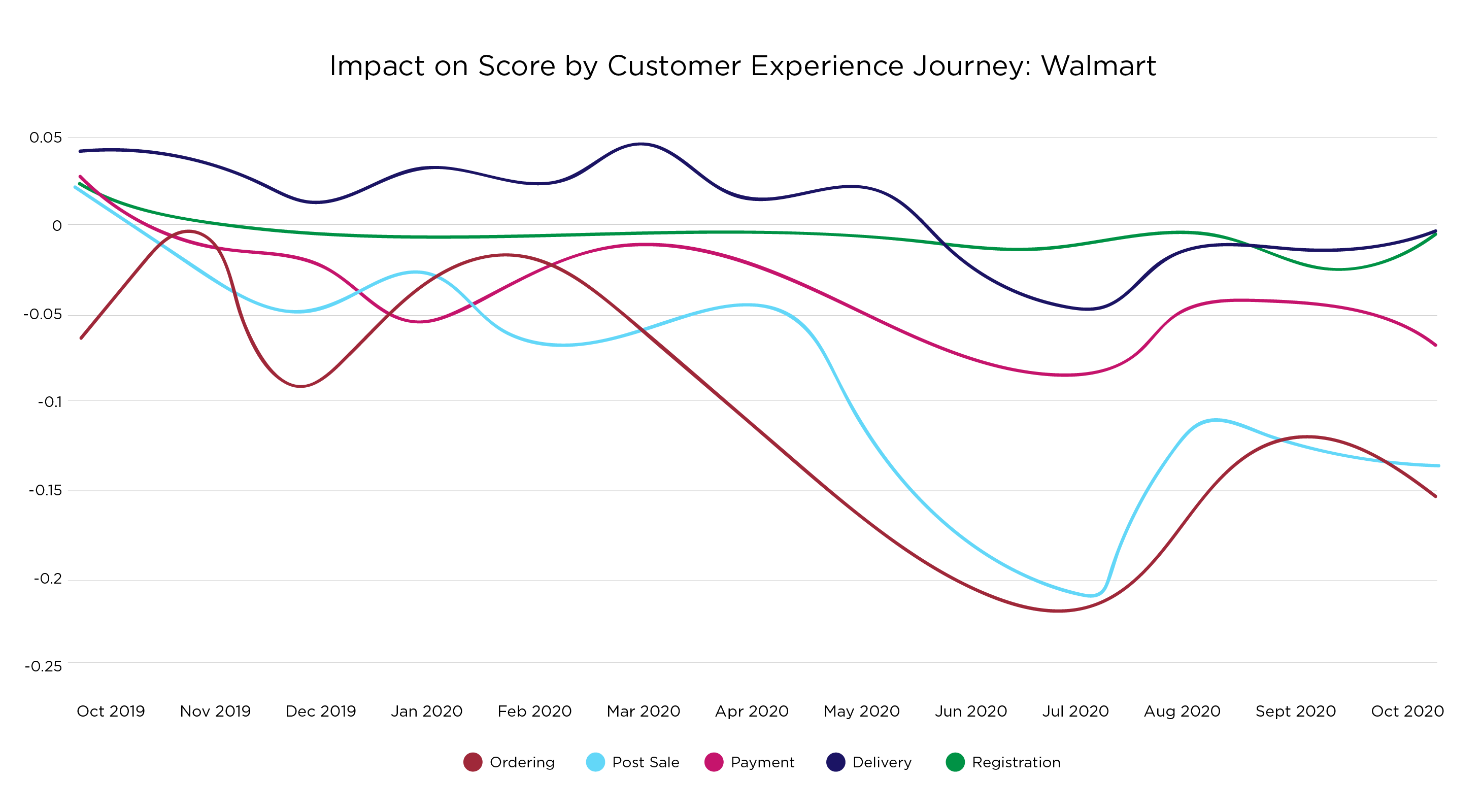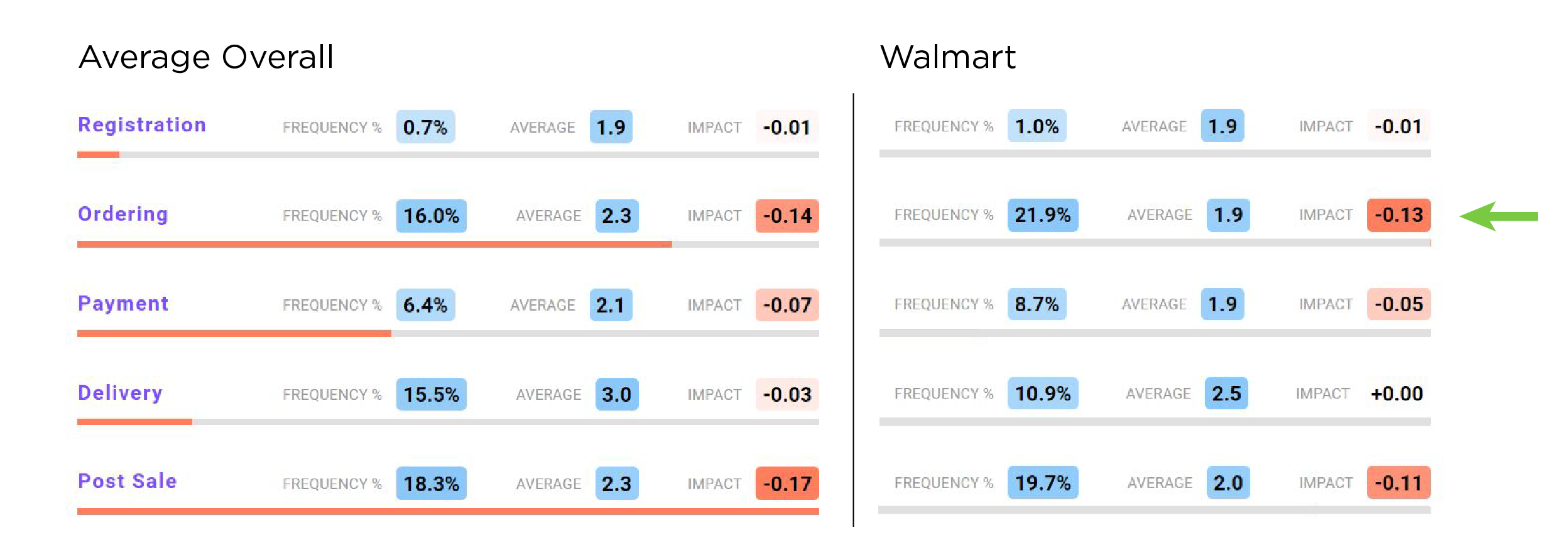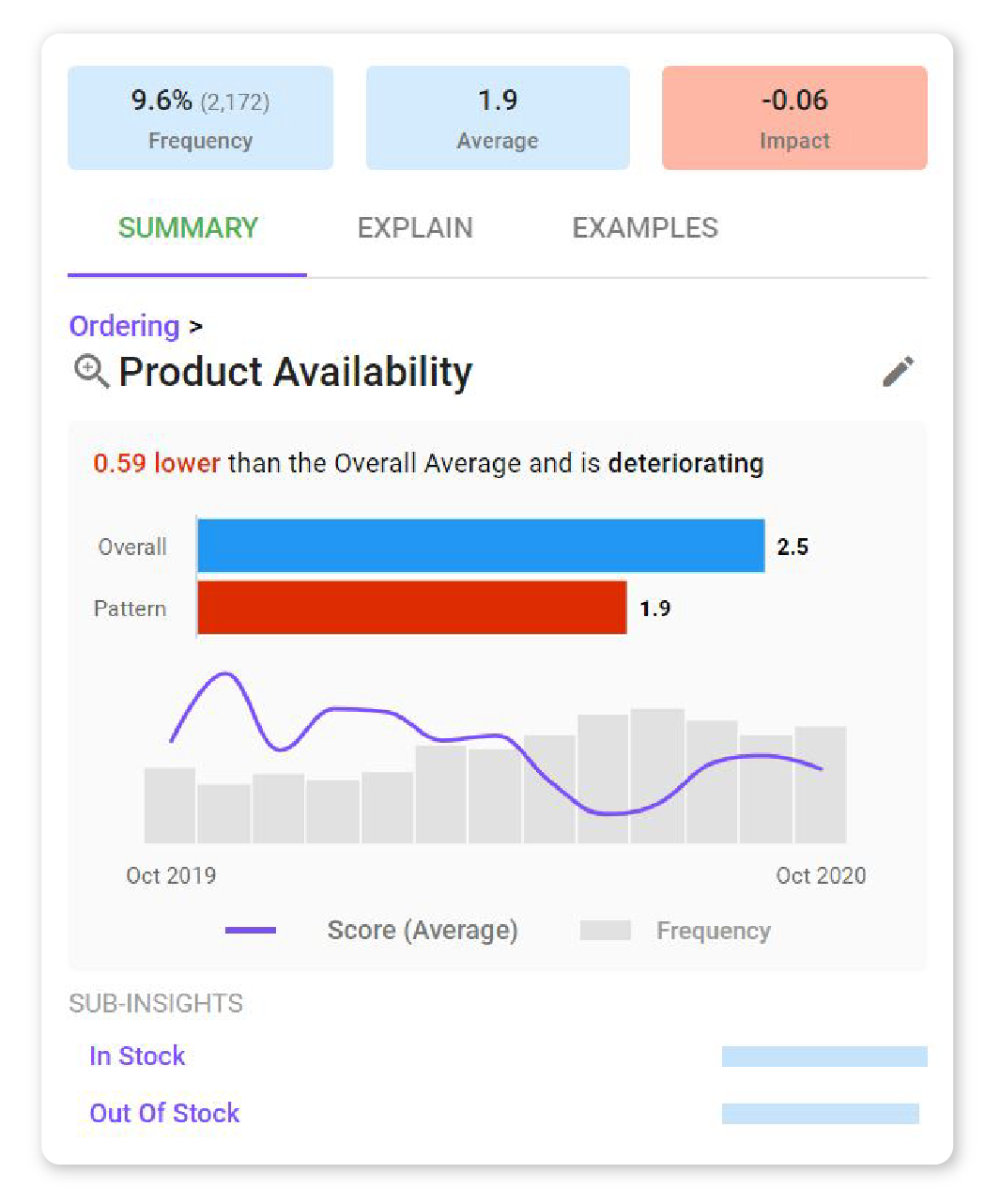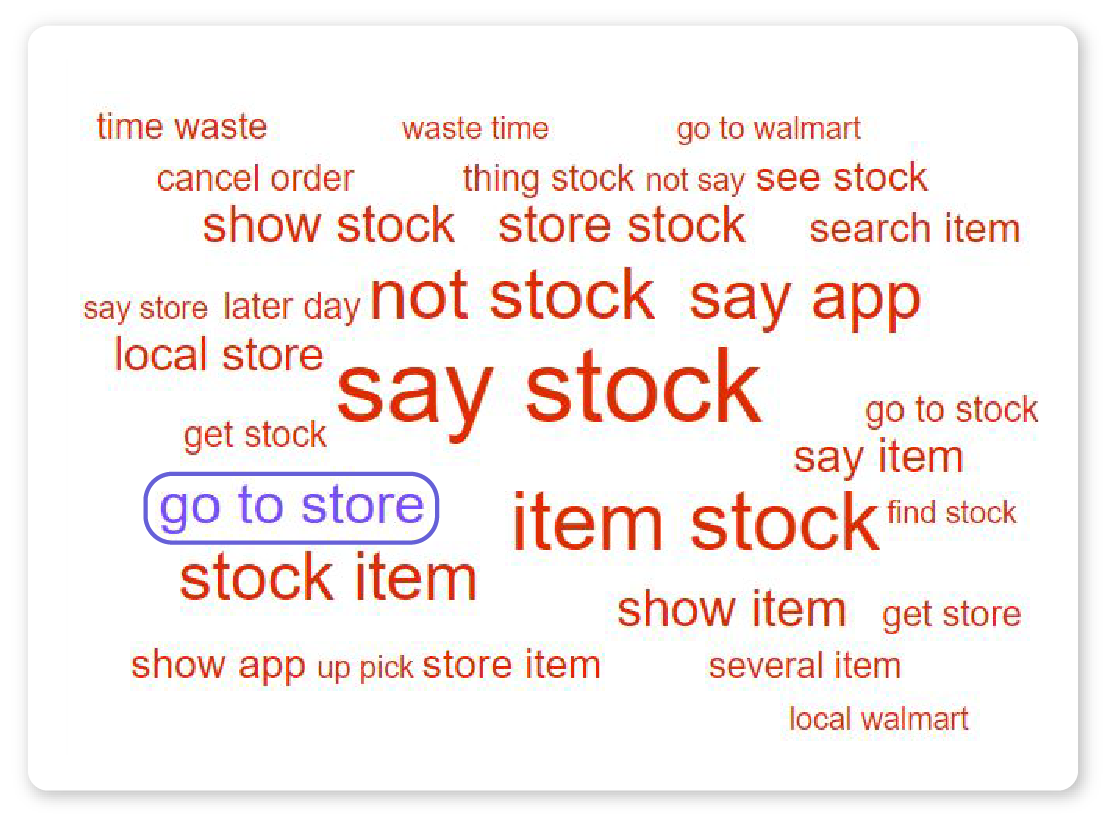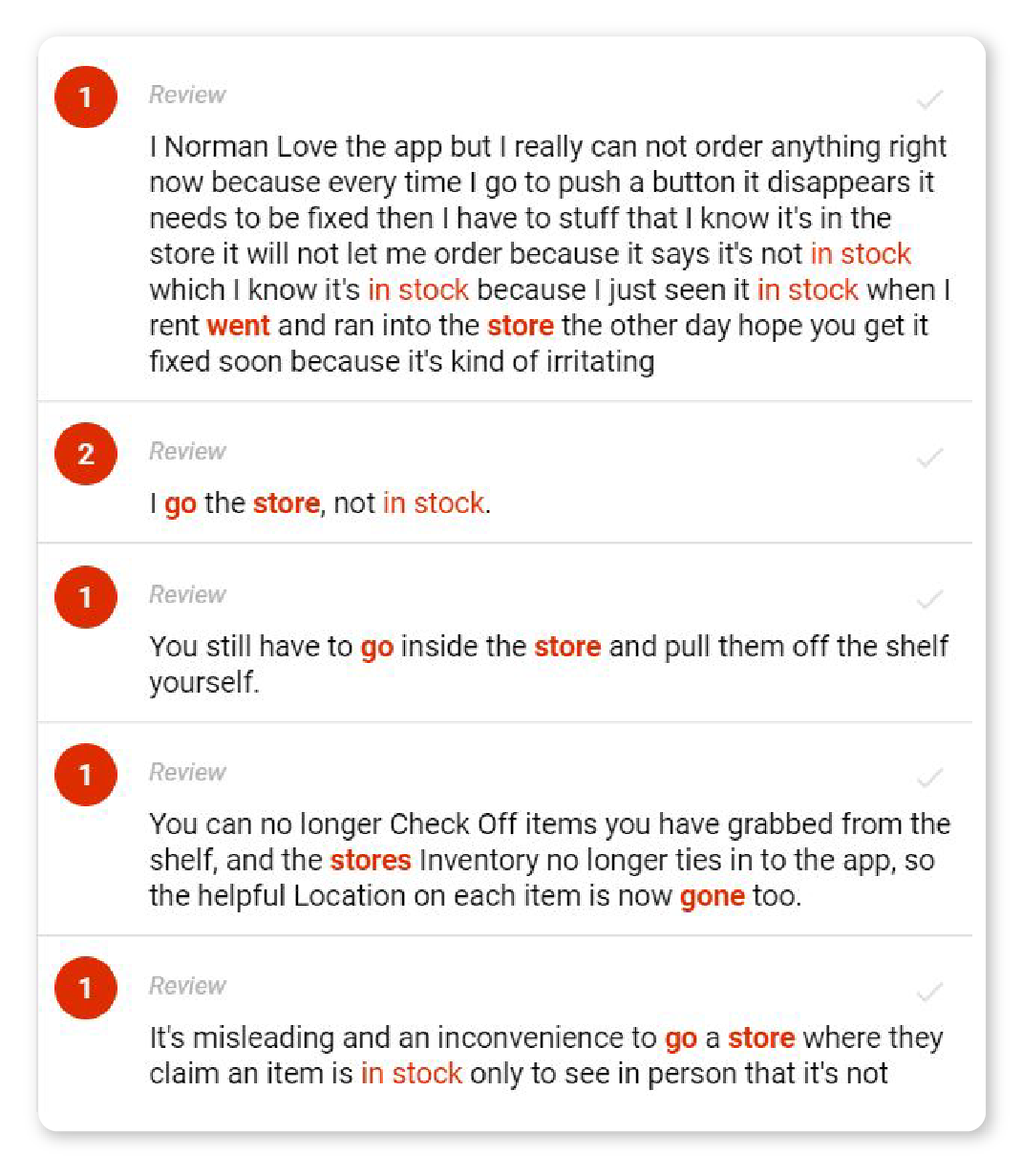Key Findings:
- Compare experience against similar eCommerce businesses (globally) to gain a high-level overview of your market positioning and gauge industry average based on consumer expectations. Understand individual aspects in which your business performs better or worse than others in-market.
- Use trend analysis to understand how external market changes or platform changes, such as new product launches or bugs, impact conversion and buyer behaviour.
- Analysing the customer experience journey on your eCommerce platform will give you a structured understanding of the issues customers have as they interact with your business, and a data-driven framework you can use to determine which improvements will have the highest impact on customer retention.
Introduction:
We analysed 74,500 reviews to uncover ways for Walmart to improve conversion and retention on their eCommerce platform in the face of Covid-19. Using the Touchpoint Ipiphany Customer Experience Journey framework we examine;
- Competitor Analysis to understand market positioning
- Trend Attribution to diagnose the effect of internal and external changes
- Granular analysis to determine the root cause of issues contributing to a decrease in customer lifetime value
________
In 2019, online sales accounted for 14.1 percent of all retail sales worldwide. This figure is expected to reach 22 percent in 2023, and with Covid-19 dramatically reshaping the eCommerce world, this number is expected to rise even further.
With this trend set on a firm upward trajectory, eCommerce businesses must pay close attention to all forms of customer experience feedback to capitalise on the opportunity to capture and retain customers as shopping habits shift. Touchpoint Group’s AI customer feedback analytics tool, Ipiphany, enables businesses to read and analyse customer feedback and review data from a range of sources, making it possible to benchmark against competitors, compare platform performance, and determine the exact cause for issues contributing to a decrease in customer experience satisfaction, conversion and loyalty.
The following case study illustrates how Touchpoint Ipiphany’s AI customer analytics can be used to detect and prevent issues that lead to customer churn and improve retention and lifetime value for an eCommerce platform like Walmart.
Case study business: Walmart
Walmart is a retail shopping corporation founded in 1962. It is the world’s largest company by revenue, with over USD 500 billion in 2019*. Online sales in 2019 accounted for 8% of Walmart’s total revenue, although this is expected to increase to 11% in 2020**.
This case study analyses
- Anonymised publicly available review data from Trustpilot, productreview.au, along with android and apple app stores.
- 74,500 reviews containing unstructured text comments over a 12 month period.
To help Walmart understand
- Platform and market positioning between 9 major eCommerce businesses worldwide.
- Reasons behind a decline in the platform performance seen over the COVID period.
- Pain points experienced by customers that resulted in a decrease in conversion, retention, and repeat purchase frequency.
The data in this study has been filtered to exclude product-based reviews, and instead focuses on reviews related to the shopper’s online experience with the eCommerce platform. While the reviews have been collected from a range of sources, each prompt asked the reviewer to assign a rating from 1-5 and then asked ‘Why did you give this score?’
Key Objectives
Using the AI Analyst, Ipiphany, Touchpoint Group was able to extract and understand the unstructured text data that is readily available through public review platforms. The objective in this instance is to reinforce the eCommerce platform direction and strategy, identify opportunities to improve sales conversion, reduce operational costs, and improve repeat purchase.
These outcomes are achieved using a predefined Customer Experience Journey framework specifically designed using Touchpoint Group’s AI Ipiphany, to set clear expectations that meet the needs of customers, leading to measurable improvements in eCommerce platform performance.
- Competitor Analysis: Benchmark against others in the industry using public review data against a standardised system of performance pillars to gauge opportunities and understand market positioning.
- Trend Attribution: Understand how COVID-19 or other external factors impact performance, as well as the impact new launches, campaigns, or potential bugs, have on conversion.
- Customer Experience Analysis: Focus on customer retention, buyer behaviour, and churn prevention throughout each stage of the customer journey; diagnose and understand which issues need to be addressed first for the greatest ROI impact.
- Granular Detail: Delve into the ‘why’ behind platforms lower-than-average rating by analysing feedback and determining root cause with enough detail to identify solutions.
Competitor Analysis
We collected public review data on nine similar eCommerce businesses, each of which holds a unique position in its market. While we recommend benchmarking your eCommerce platform against close in-market competitors, this diverse, international range of industry leaders is useful in illustrating a baseline standard to use for comparison.
By comparing the experience of shopping online at Walmart to other eCommerce stores, we’re able to gain a high-level overview of their market position and delve down to understand individual aspects in which Walmart performs better or worse than others in the market.
The average score across our sample is 3.2, while Walmart’s score is 2.5. AliExpress comes in with an impressive 4.2 - this is worth noting for further analyses as it provides a good foundation for areas of potential growth and opportunity for Walmart.
Using Ipiphany’s Compare tool, we can identify the main topics discussed in customer feedback to understand what drives the components of these scores up or down.
- Booktopia and Aliexpress are both breakout stars when it comes to platform performance- they consistently rate higher than any other platform in the categories highlighted.
- Refunds and Returns are rated lower across the board - this is not unexpected, as public reviews tend to contain a higher concentration of negative over positive reviews, and these topics often result in the core reason a user leaves a review
By measuring Walmart against these platforms, we can highlight that they are meeting industry average and consumer expectations, however, it also provides direction for further analysis of areas for improvement and opportunity to better their service and offering, specifically around pain points present in the ordering, payment, and post-sale processes.
See Granular Detail, to find out how Ipiphany determines the root cause of underlying issues in these areas.
Trend Attribution
A trend analysis plots data points over time, making it easy to understand how external market changes or platform changes, such as new product launches or bugs, impact conversion and buyer behaviour. In this example, an overall view of platform scores clearly illustrates the impact that COVID-19 had on customer experience throughout 2020.
While all the platforms experienced movement in scores attributable to the increase in online shopping, Walmart, Amazon, and AilExpress all had a considerable drop. After June, Amazon and Walmart started to see a rise in ratings and performance.
To learn more about the cause for the dip in Walmart’s data in May and June, let’s filter to their data and analyse the key concepts in the feedback once again.
Here, we've extended our view back to October 2019 to establish a benchmark for the data. By understanding the stage of the customer journey that suffered the biggest decline, we can narrow down potential issues - in this instance, we can see that reviews discussing the ordering and post-sale process are much more negative - thus providing a quick insight into the platform's key weakness. We can investigate this trend further by analysing the entire customer journey focusing on these two key topics.
Ipiphany allows you to map changes in customer experience against internal data so you can truly understand the impact internal processes, development or changes have made to the overall customer experience.
Customer Experience Analysis in granular detail
Touchpoint Group has developed a standardised approach to achieving an understanding beyond the customer journey, encompassing not only a customer’s actions and behaviours throughout the completion of the ordering process, but also the interactions, impressions, and experiences they have along the way.
Analysing the customer experience journey on your eCommerce platform will give you a structured understanding of the issues customers have as they interact with your business, and a data-driven framework you can use to determine which improvements will have the highest impact on customer retention.
By comparing the overall average from our combined data set to Walmart’s scores, one immediate element stands out. While approximately 16% of the whole dataset discusses “Ordering”, which results in an average overall score of 2.3, 21.9% of Walmart customers discuss this topic with a score of 1.9, highlighting it as a key area of concern for Walmart and one, that if resolved will actively increase their average score rating and without doubt, platform sales performance.
Understanding that this issue relates to the ‘ordering’ process isn’t enough information to make informed decisions and see improvement quickly and efficiently. By delving further still into the topic, we can start to define the root cause of the issue.
Upon further analysis we can attribute the fundamental issue customers are experiencing revolve around product availability within the ordering process, specifically relating to ‘in stock.' This issue is rated .79 below the overall average, and seems to be rising in frequency over time. Although we’ve discovered the category of Walmart’s ordering issue and we understand the impact it has on the score, we still don’t understand what the issue is: let’s drill down further to find out.
Ipiphany displays the themes of the comments within this category- things like ‘item stock’, ‘say stock’ and ‘go-to store’ - we can also see evidence of an emotional response in the word cloud - ‘waste time’. From here, let’s read a few of the customer comments in this category to truly understand the issue
In just a few sentences, the root cause is illustrated by a customer’s explanation of their experience. Walmart’s eCommerce platform appears to be out of sync with stock levels in-store - customers report that items listed as out of stock are available in the store, and voice frustrations that they have to waste time going into a local store to pick up the items they need.
Using Ipiphany, we’ve determined that fixing this stock-counter issue in Walmart’s eCommerce platform would improve their overall score from 2.5 to 2.6, as well as eliminating the need for customers to visit their local store in person when they would have preferred to shop online. The level of detail revealed by Ipiphany provides enough information for Walmart to hand over this issue to the eCommerce team for investigation and resolution.
The analysis for this case study was carried out within a few hours of downloading publicly available data - almost immediately, our team will determine the root cause of a specific issue contributing to customer experience. Contact us to schedule a demo or for more information on how Touchpoint Group can help analyse your customer experience data to improve customer lifetime value, reduce churn, and improve retention.
Sources
*https://en.wikipedia.org/wiki/Walmart
**https://www.forbes.com/sites/greatspeculations/2020/03/02/how-much-in-online-revenue-can-walmart-generate-in-2020/
